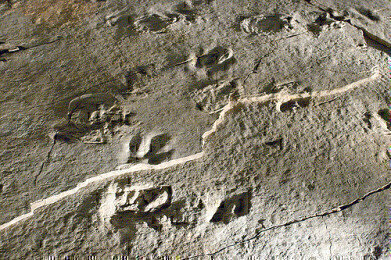News
How do Footprints Become Fossils?
Mar 12 2016
Today, fossilised footprints play a wildly important role in helping palaeontologists understand what walked the planet hundreds of millions of years ago. But how does a single imprint manage to maintain its impression, despite the ravages of time?
When an animal ambles across a soft sediment such as mud or sand, its tracks are left behind in its wake. While most of the time they’re simply washed, blown or eroded away, some have serious staying power. Staying power that’s endured 231.4 million years, at least according to the scientists that used radiometric dating to identify fossilised footprints made by Eoraptor lunensis, one of the world’s earliest known dinosaurs.
Frozen in time
One way tracks can be preserved is by being encased in a layer of sediment. This settles over the top of the prints and protects them from external forces. Another way tracks are preserved is when a foot, paw or claw sinks deep into the sediment, and creates a print well below the surface. When made so deep, even the harshest of elements can’t erode it.
Generally, palaeontologists prefer tracks that are covered with a sediment that has different characteristics from the matter in which the print was originally made. For example, prints made in mud and covered with sand tend to be much more prominent than sand on sand. Of course, this isn’t essential. The bottom line is that when buried under the right conditions, tracks can become frozen in time. Sometimes, for hundreds of millions of years.
A perfect day for preservation
So what makes for good conditions? Ideally, optimal preservation occurs when sediments harden. This is a process known as lithification, which sees sediments compact or bind together using mineral cement. Most of the world’s oldest known tracks were made in wet environments, as they’re better at retaining imprints. However, even sand dunes can retain prints when moisture in the air turns to dew.
As expected, not all tracks tell the same stories. When prints are high in morphological detail they’re known as true tracks, and reveal in-depth information such as skin detail. When tracks are indistinguishable yet still leave a pressure mark, the weight leaves an indentation known as an undertrack.
Often, fossils lie undisturbed and unidentified for millions of years. Until they’re uncovered, scientists have no idea they even exist. In the same way, new laboratory developments are also helping scientists make exciting advancements in microscopy. For more insight into the latest developments, ‘Seeing is Believing: High-Resolution Cryo Electron Microscopy reveals Mechanism of Virus Assembly and Genome Encapsidation’ is a must read article.
Image via Flickr Creative Commons. Photo credits: Ken Kirkel
Digital Edition
Lab Asia Dec 2025
December 2025
Chromatography Articles- Cutting-edge sample preparation tools help laboratories to stay ahead of the curveMass Spectrometry & Spectroscopy Articles- Unlocking the complexity of metabolomics: Pushi...
View all digital editions
Events
Jan 21 2026 Tokyo, Japan
Jan 28 2026 Tokyo, Japan
Jan 29 2026 New Delhi, India
Feb 07 2026 Boston, MA, USA
Asia Pharma Expo/Asia Lab Expo
Feb 12 2026 Dhaka, Bangladesh



















